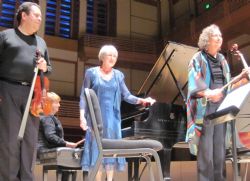|
Other
CHARMING "BARBER" A MENDO FESTIVAL TRIUMPH
by Pamela Hicks Gailey
Friday, July 21, 2023
Other
JOYFULLY WE SING
by Pamela Hicks Gailey
Thursday, February 23, 2023
Other
SUBDUED PIANISM IN RARE FORTEPIANO RECITAL IN THE RAVEN
by Terry McNeill
Sunday, February 12, 2023
Other
DINOVA PIANISM CHARMS SATED AUDIENCE AT J-B MARIN RECITAL
by Terry McNeill
Sunday, November 20, 2022
Other
CLEARY'S NEW ORLEANS BAND IGNITES PARTY FOR THE GREEN AT SSU
by Terry McNeill
Saturday, September 25, 2021
Other
SIX GUITARISTS IN UNIQUE NAPA RECITAL
by Gary Digman
Sunday, July 25, 2021
Other
STUNNING LINCOLN CENTER CONCERT LAUNCHES FIFTH WEILL SEASON
by Philip Beard
Saturday, October 1, 2016
Other
LATE BEETHOVEN EXPLORED AT MMF CONCERT IN PRESTON HALL
by Paula Mulligan
Thursday, July 21, 2016
Other
ANGUISH AND TRIUMPH IN MENDOCINO FESTIVAL'S BIG TENT
by Kayleen Asbo
Sunday, July 10, 2016
Other
ARCANE ARENSKY TRIO HIGHLIGHTS NAVARRO'S SEASON OPENING CONCERT IN SCHROEDER
by Terry McNeill
Sunday, October 4, 2015
|
 |
 Trio Navarro in 2014 |
ARCANE ARENSKY TRIO HIGHLIGHTS NAVARRO'S SEASON OPENING CONCERT IN SCHROEDER
by Terry McNeill
Sunday, October 4, 2015
One would have thought that the glitz surrounding Lang Lang’s 101 Pianists Foundation program Oct. 4 in Weill would have upstaged chamber music at the same time in nearby Schroeder Hall. Not to worry, as the Trio Navarro continues to perform sometimes-neglected gems from the trio literature with a level of artistry that the Chinese superstar might grandly applaud.
In Rimsky-Korsakov’s My Musical Life he writes in 1905 that the works and life of his pupil Anton Arensky “…will soon be forgotten.” And that has mostly been so, with the exception of piano bagatelles, some suites, two string quartets and the first Trio in D Minor. The Navarro programmed the rarely heard second Trio in F Minor, Op. 73, for the second half of the concert, and scored a minor triumph with it before an audience of 125.
The Trio choose quick tempos and clipped phrases in the opening movement, eschewing extended ritards and the voice leading one hears in recordings of Arensky by Russian musicians. It’s Tchaikovsky influenced a bit by Schumann. A surprisingly movement ending accelerandowas played swiftly and vigorously. In the lyrical second movement pianist Marilyn Thompson played the opening expressive theme and throughout the music from 1905 is achingly rich, but even here in opulent thematic voices traded between violinist Victor Romasevich and cellist Jill Rachuy Brindel one hoped for a little more loosening of tempo. Mr. Romasevich held one high note at the end of an ascending phrase with just the right character of suspense and bright tone.
A Scherzo comprises a wonderful trio in a waltz form, and the concluding “Tema con Variazioni” with a big cello part portraying music that is less exalted than the preceding movements. It’s episodic until the return of the first-movement’s dark theme, and the Navarro played it with conviction. Brahms’ last movements are always imposing; Arensky’s are less so.
Before intermission the Navarro played trios by Haydn (B Flat Major, Hob XV:20) and the venerable Dvorak E Minor (“Dumky”). Haydn wrote more than 40 piano trios, and in most the cello supports the violin’s stating principal themes. It was this way in the first two movements with Mr. Romasevich’s light vibrato and a simple and long introductory line from Ms. Thompson in the Andante Cantabile. At times this Trio sounded like an accompanied piano solo, brisk and and pungent.
Dvorak’s famous Dumky has often been played by the Navarro, but with violinist Roy Malan. It’s a masterful work of vitality and infectious Czech rhythmic power in six alternating dumka of festive gaiety and yearning, though alike in character. The Navarro performed the demanding rhythm patterns with seasoned artistry. A highlight was the lovely recitative in the Poco Adagio sounding with Ms. Brindel’s plaintive cello melody, and the Cantilena in the piano part. In the fourth dumka again the cello carried a melancholy theme over the bass lines of piano and violin, and this created a sense of warm calm.
The final dumka (Lento) had the Navarro playing up the disparity of a grave pathetic theme with a wild quick section, and Ms. Brindel as earlier had prominence with her assured cello technique.
The repertoire selection and performance gave me no reason to change a decade-long view that the Navarro is the best resident piano trio in Northern California.
|
